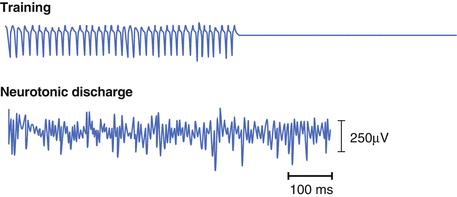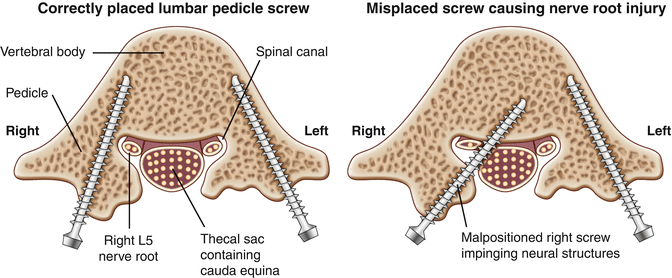Fig. 8.1
A motor unit is shown with a recording electrode in proximity. Individual muscle fiber potentials are recorded in sum as the motor unit action potential (MUAP)
EMG recordings are made from either surface electrodes or needles placed directly into the muscle(s) of interest [9]. Intraoperative EMG testing can involve passive muscle recordings for the purposes of detecting cranial nerve or nerve root irritation (known as spontaneous EMG or S-EMG) or may involve electrical stimulation of neural elements or hardware for the purposes of assessing function (known as triggered EMG or T-EMG).
Spontaneous EMG
Spontaneous EMG is used as a means of monitoring cranial and spinal nerves during surgery. The premise is that impending injury to these structures by stretch, compression, or other forms of mechanical irritation will cause them to increase firing which is detectable as CMAPs in the monitored muscle groups [10–14]. Ischemia usually does not induce action potential firing and thus is poorly detected by EMG. Proper selection of muscles to monitor is key to the success of S-EMG monitoring.
Many of the cranial nerves that are routinely monitored with EMG have sensory or autonomic components in addition to the monitorable motor component. In these cases, EMG is used as a sentinel for function of the entire nerve, even if the motor component is the smallest functional component of the nerve. If the motor division of the cranial nerve includes branches, it is appropriate to monitor the muscles innervated by each branch whenever possible.
Spinal nerves are mixed (sensory and motor) nerves that may be monitored for irritation with spontaneous EMG [11, 12, 14]. Spontaneous EMG monitoring differs from other intraoperative neuromuscular monitoring modalities in that the expected or normal state is the lack of response due to the absence of any muscle activity [12]. This indicates that a normal healthy nerve has not become activated as a result of surgical stimulation.
Interpretation of intraoperative EMG depends on a familiarity of the various types of firing patterns commonly seen. Various responses may be seen during EMG monitoring. Some patterns of spontaneous activity are suggestive of nerve root irritation or injury. If preexisting nerve root irritation is present, the baseline EMG recording will often contain low-amplitude periodic firing patterns [1].
The clinical significance of the EMG firing pattern can be generally considered proportional to the frequency, amplitude, and persistence of the firing. Waveforms occurring at high frequency and amplitude indicate multiple motor units involved and a higher likelihood that the firing pattern is a warning of an impending injury. The correlation of EMG activity with a surgical event (such as retractor placement or hardware insertion) suggests a causative event and reversal or cessation of the event should result in a return to the baseline EMG pattern. Persistence of EMG firing beyond cessation of the causative event is worrisome and suggests that injury to the nerve may have already occurred.
Random activation of one or a few motor units during surgery may occur with incidental contact with the neural elements and is not considered clinically significant. These waveforms are termed spikes when the activity of one motor unit is recorded or bursts when the waveform is generated by activation of several motor units (Fig. 8.2). It is important to remind ourselves that the MUAP or spike is actually the recording of a compound action potential consisting of the individual muscle fiber action potentials. As such, its morphology is distinctly different than a single action potential generated by a muscle cell or a neuron. Specifically the duration of the event is longer, often several milliseconds. These waveforms are also polyphasic as opposed to biphasic. Spiking or bursting in the EMG indicates proximity to the neural elements and may be a useful information to the surgeon while navigating the field.


Fig. 8.2
An example of EMG spikes (upper panels) and bursts (lower panels)
Sustained activation of multiple motor units results in firing patterns with a greater degree of clinical significance. EMG “trains” are repetitive prolonged firing of one or more motor units, lasting from seconds to minutes [9]. The length of time a nerve is activated is dependent on the degree of nerve irritation [15]. Significant nerve irritation or nerve damage can produce neurotonic discharges in which no individual muscle action potentials are distinguishable [13] (Fig. 8.3). These two patterns of activity are ubiquitously recognized as warning criteria for nerve or nerve root injury and should be reported to the surgeon immediately.


Fig. 8.3
An example of training and neurotonic discharge in an EMG recording
The use of audio output of the EMG signal is very useful to the surgeon in providing real-time data for both navigating the surgical field as well as warning of impending injury to the neural elements. The use of real-time audio feedback enables the surgeon to respond with immediate correction or to be more aggressive with his approach based on the data.
Triggered EMG
Triggered EMG is used for three primary reasons: to identify a nerve or nerve root of interest, to assess the functional integrity of a nerve or nerve root, and to assess the placement of pedicle screws.
Identifying Nerves and Nerve Roots
Direct electrical stimulation of a nerve or nerve root can assist in its identification. Due to redundancies of innervation patterns, accurate identification of a branch of a cranial nerve or the level of a nerve root requires specific monitoring of CMAPs using a bipolar recording montage (see Chap. 4).
Stimulating a nerve or nerve root directly is best accomplished with a handheld bipolar probe. A bipolar probe will reduce the size of the current field and increase the specificity of stimulation. Square wave pulses with a pulse width of 50–100 μs are delivered at a rate of approximately 2 pulses per second.
A healthy neural tissue should stimulate at an intensity of less than 2 mA and produce a recordable CMAP. When setting the display parameters, it is important to keep in mind both the latency and amplitude of the expected response. Most CMAPs can be several millivolts in amplitude. The latency is dependent on the distance between the stimulation and recording site. For most cranial nerve monitoring, the latency will be between 2 and 10 ms. For spinal nerve roots, the latency is longer.
Assessing the Functional Integrity of a Nerve or Nerve Root
Direct electrical stimulation is also used to assess the health and function of a nerve root. Healthy nerves have a stimulation threshold well under 2 mA and often under 1 mA. The use of direct nerve stimulation to provide diagnostic information concerning cranial and spinal nerves is based on the premise that previously injured or chronically compressed nerves have a higher electrical threshold for activation [16]. This concept has been extended in the use of pre- and post-tumor resection thresholds for providing prognostic information about cranial nerve function [17, 18]. There are technical considerations that should be taken into account when stimulating nerves directly in the surgical field that may reduce the sensitivity and specificity of stimulation. As mentioned above, the use of a bipolar stimulating electrode is preferred for the task of direct nerve stimulation. Furthermore, it is imperative that the surgical field is dry to prevent the shunting current away from the intended stimulation target. Current shunting may result in failure to stimulate the structure or create an artificially high stimulation threshold.
Stimulating Pedicle Screws
Pedicle screws are used in surgeries for the correction of spinal deformity as well as for procedures to decompress neural elements and reduce pain and neurologic symptoms. The function of pedicle screws is to stabilize vertebral bodies following laminectomy and/or discectomy until bony fusion of the adjacent levels is complete. Pedicle screws are placed through the pedicle and into the cortical bone of the vertebral body with care not to breach the pedicle and enter the vertebral canal causing spinal cord or nerve root injury (Fig. 8.4). Blind placement of pedicle screws without EMG or imaging guidance carries a higher risk of neurologic injury [19, 20]. Neurologic injury resulting from misplaced pedicle screws can be either radiculopathic (involving a nerve root) or myelopathic (damage to the spinal cord).


Fig. 8.4
Correctly placed and misplaced lumbar pedicle screws
Accurate placement of pedicle screws is optimized by the use of both intraoperative imaging and electromyographic guidance [7, 10, 14, 21–25]. Imaging techniques have evolved from plain radiographs to fluoroscopic guidance and most currently intraoperative computerized tomography (CT) techniques [26–28]. Stimulation of pedicle screws cannot determine good bone purchase, but instead can indicate the presence of a pedicle wall breach with reasonable sensitivity. This technique is best used together with imaging guidance and visual inspection.
Stay updated, free articles. Join our Telegram channel

Full access? Get Clinical Tree







